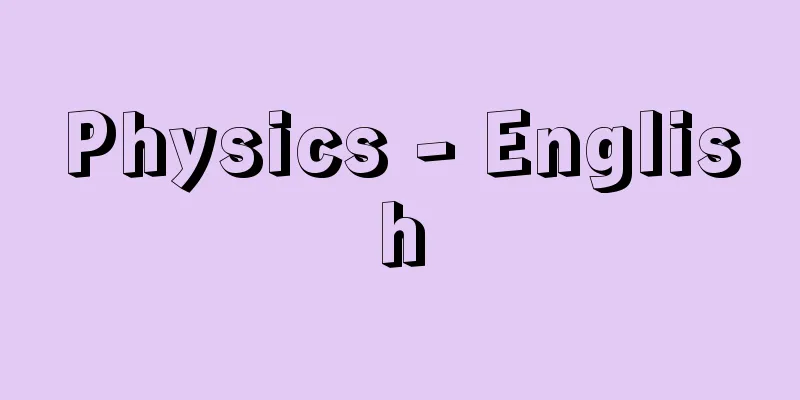Physics - English

IntroductionThe origin of the word physics, physic (φυσιξ), originally meant nature in Greek. Therefore, Aristotle's Physica is translated as "Physics". He devotes many pages to discussing "motion". Aristotle's "motion" includes birth and destruction, increase and decrease in quantity, qualitative change, and spatial movement. What we currently refer to as motion in the narrow sense is this last one. However, Aristotle's motion can also include chemical changes and life phenomena. In this way, Aristotle's Physica is a book on physical science rather than physics. However, he leaves the specific descriptions of animals and plants to other works, and in this book he discusses motion in a broad sense in a general and fundamental way. This method has been passed down to modern physics, and there is a reason why the modern word "physics" is used for physics. Incidentally, natural philosophy was used to mean physics until the 18th and 19th centuries. However, in the second half of the 18th century, physique came to mean physics alongside chemistry, as can be seen, for example, from the publication of a paper by the Frenchman Lavoisier in Opuscules physiques et chimiques . In the 19th century, in addition to mechanics and optics, thermology and electromagnetism were perfected, and the concept of physics as a synthesis of these was established along with the word itself (just to be clear, physiology means physiology, and physician means doctor, not physicist, but in French physicien means physicist, not doctor. This is because physic originally meant nature or body). In the 19th century, " Annals de chimie et de physique " and " Journal de physique " appeared in France, and " Annalens der Physik und Chemie " appeared in Germany. Many important papers in the history of physics were published in these journals, and it is believed that physics established an important position in the natural sciences alongside chemistry, with the use of words such as "physique" and "Physik" emerging. [Shohei Miyahara and Shuji Takagi] Physics SubjectsThe subject of physics is natural phenomena, but this is too broad to distinguish it from other natural sciences. However, it is difficult to limit its scope. This is because, like other branches of natural science, physics is constantly expanding and changing its thinking and subject matter while taking into account past progress. It was once said that "physics studies the movement of objects, while chemistry studies the changes in matter." In this sense, objects are limited to certain shapes and sizes, whereas "matter" as the subject of chemistry means things that are uniform and do not have a specific shape or size but have certain properties, such as air, water, or copper. However, the word "matter" has a broader meaning. When we think of natural matter, we do not only think of air, water, or copper, but also of celestial bodies such as stars and the sun, that is, "matter" in the universe. Furthermore, modern science has revealed that "matter" as chemists refer to is a collection of tiny "objects" called molecules and atoms. From a modern perspective, the subject of physics should be "the matter and its movement that causes natural phenomena." Furthermore, the characteristic of physics is that it seeks to unify as much as possible the universal laws that lie behind these natural phenomena. In classical mechanics, which began with Galileo in Italy and was practically perfected by Newton in England, the subject is not only "objects" on Earth, but also celestial bodies such as the moon and planets. However, in this case, the "object" is ignored, and attributes such as "mass" are extracted. In addition, when talking about "motion," the focus is on "position" and its change. However, with the subsequent development of physics, the subject has come to include stars and the things that make them up, that is, "matter." In addition, when talking about "motion," it does not only mean the movement of objects in the narrow sense, but also includes changes in attributes of interest, such as the propagation of light and the change from liquid to gas. Furthermore, physics studies not only the structure and movement of matter, but also the structure of "space and time," the framework that determines that movement (general theory of relativity). However, such a definition does not yet clearly distinguish between physics and other natural sciences. For example, some modern physicists believe that chemistry has been subsumed into physics. It is true that the research fields of physics and chemistry have mutually penetrated each other in modern times. However, the same can be said about the boundaries of all individual sciences, and it is not correct to think that the distinction between physics and chemistry has disappeared. [Shohei Miyahara and Shuji Takagi] At the boundary between physics and chemistryThe characteristics of the subject of physics compared to that of chemistry are as follows. First, physics seeks to recognize the basic structure and general motion of all objects in nature. Of course, physics also studies the laws of motion and structures specific to specific objects, but they are always studied in relation to general things, in order to explore or verify more universal laws, or to see the manifestation of structures that are considered to be more fundamental. In this way, the subject of physics ranges from the big problems of the universe and galaxies to the small problems of atoms and elementary particles. In contrast, chemistry studies the structure and changes of molecules (which can also be considered the basic units of chemical species) and molecular bonds that are composed of atoms. At first glance, this research subject of chemistry seems to be only a part of the subject of physics, but in fact it is not. It is not just that the variety of compound molecules made up of dozens or more than 100 types of atoms is enormous. Among them, there are concepts specific to chemistry, such as atomic valence, bond, radical, oxidation/reduction, etc. It may be possible to ground these concepts that have a material correspondence in physics, that is, in the general laws of motion of basic substances. However, this does not mean that these qualitative concepts, which are specific to chemistry, are resolved into the laws of physical motion. This is the same as, for example, when the substances that make up living organisms are chemically analyzed and some of the phenomena of life are based on physics and chemistry, this does not mean that life is reduced to inorganic substances. Among natural substances, "living things" are special, and for the time being are excluded from the subject of physics research. Of course, the research fields of biology and physics are also penetrating each other. However, even though biological substances are being incorporated as the subject of physics research, the distance between physics and biology is much greater than that between physics and chemistry. The emergence and growth, or proliferation and evolution of individual living organisms are concepts unique to living organisms, and it would be fair to say that we are still a long way from understanding them from the perspective of physics, which is basic matter and its general laws of motion. [Shohei Miyahara and Shuji Takagi] Physics MethodsPhysics, like other branches of the natural sciences, is studied by experimental and theoretical methods. In a broad sense, "experiment" includes observation and monitoring. However, physics places emphasis on so-called precision experiments in the narrow sense of "experiment," that is, experiments in which environmental conditions are adjusted, the values of various parameters are controlled, and a physical quantity is precisely measured, or a quantitative functional relationship between two quantities is found. This is closely related to the fact that physics emphasizes the quantitative aspects of motion in its research. At the same time, however, the qualitative discoveries made through experiments are also of great significance. Good examples of this are the discoveries of X-rays, radioactivity, and superconductivity. The theoretical method of physics is characterized by the broad and deep application of mathematics according to the quantitative precision of the experiments. Many branches of mathematics are used as tools for theoretical research in physics. However, the theoretical method is not limited to the application of mathematics. Analogy, idealization, and model setting also play extremely important roles in theory. This can be seen, for example, by considering whether atomic theory could have been established without the formation of the atomic model. Moreover, theoretical methods are not only used to interpret experimental results. In order to pursue the fundamental issue of physics, namely, a unified understanding of various laws, it is important to set a theoretical issue, namely, within what conceptual framework these laws should be understood. We must not forget that Einstein's theory of relativity was created not as an interpretation of the Michelson-Morley experiment, but as a solution to the theoretical issue of unifying mechanics and electromagnetism. Experimental and theoretical methods are not simply in series or in parallel, but are intricately intertwined, sometimes helping each other and sometimes contradicting each other, while as a whole they play a role in deepening our understanding of physical nature. Some experiments are useful for verifying a theory, while other experimental discoveries contradict previous theories, and therefore often help to develop theories and create more comprehensive new theories. In addition to experimental methods, we must also consider the development of experimental equipment and methods. This is not a research for understanding nature in itself. However, it is essential for experimental research. Similarly, the study of mathematical methods themselves in theoretical methods also has a certain role to play. When considering these methods, the most basic thing is, of course, that the method is determined by the object. Therefore, the most essential thing for the methods of physics is not individual experimental or theoretical methods or means, but the establishment of a correct view of nature. [Shohei Miyahara and Shuji Takagi] Various branches of physicsPhysics is often broadly divided into theoretical physics and experimental physics. However, this is a classification based on methods, and it is not appropriate to see it as a branch of physics that corresponds to the current development of physics. In a situation where research methods are highly specialized, the division of labor between theory and practice on the part of researchers is inevitable, but this does not necessarily represent a branch of physics. Physics has also been divided into classical physics and 20th century modern physics or quantum physics according to its history of development. The theoretical system of mechanics compiled by Newton was mathematically developed, and the discovery and exploration of various new phenomena led to the development and development of new fields such as heat, optics, and electromagnetism (with the discovery of electromagnetic waves, optics was incorporated into electromagnetism, and heat developed into thermodynamics and then into statistical mechanics). These are called classical physics, and seem to be summarized as a so-called mechanical view of nature, but in fact they contain many contradictions. In the 20th century, observations that clarified these contradictions and new phenomena were discovered, such as Michelson-Morley's experiment on the speed of light and Planck's discovery of the quantum related to the spectrum of thermal radiation. The former was linked to the theory of relativity, and the latter was combined with the pursuit of the properties of atoms to develop into quantum physics. However, although these classifications and names have historical significance, they are prone to misunderstanding. The term "classical" also gives the impression that it is outdated and no longer useful in modern times, or that there is no room for further development. However, new developments in this field even after the 20th century cannot be ignored. For example, fluid mechanics belongs to so-called classical physics, but since the 20th century, the physical characteristics of fluids have been clarified, and coupled with the development of mathematical tools, it has undergone modern developments that are a stark contrast to those of the 19th century. So how should we think about the branches of physics? Most naturally, the branches of physics should be divided according to the object and the perspective from which it is explored. Physics deals with natural matter and its motion, which is divided into various layers, each with its own laws of motion. It is natural that there are branches of physics corresponding to each layer. However, on the other hand, these layers are interpenetrating and permeated with general laws. Therefore, these branches cannot be thought of as fixed. Modern physics is usually divided into macroscopic physics and atomic physics in the broad sense, or microscopic physics. However, this division is merely expedient, and it goes without saying that the two are not completely separate. Macroscopic physics deals with objects on a macroscopic level, and much of what is known as classical physics falls into this category. Examples include mechanics (including fluid mechanics), electromagnetism, and thermodynamics. The theory of relativity is also macroscopic physics, although it may be difficult to call it classical. [Shohei Miyahara and Shuji Takagi] Nuclear Physics and Condensed Matter PhysicsAtomic physics in the broad sense is broadly divided into two parts: nuclear physics in the broad sense, and condensed matter physics. Nuclear physics in the broad sense is divided into particle physics (elementary particle theory) and nuclear physics in the narrow sense. Particle physics is the field that studies elementary particles, which are the basic components of matter, and their motion and interactions. The main elementary particles include hadrons, which include nucleons and heavy particles with strong interactions, as well as certain mesons, leptons, which have weak interactions, and electromagnetic elementary particles such as photons. They are studied in a unified manner, and their laws of motion, interactions, transformations, and conservation laws are explored. Furthermore, these elementary particles are understood at a deeper level, and various elementary particles are composed of more basic fundamental particles (quarks, leptons, gluons, etc.), and various interactions are also explained in a unified manner. Nuclear physics in the narrow sense studies the atomic nucleus, which is a multi-body system of nucleons. In terms of dealing with multi-body systems, it has similar aspects to condensed matter physics (especially in terms of methodology). However, it is closely related to particle physics in that the fundamental particles are nucleons and the fundamental interaction is the strong interaction. In fact, it has become increasingly necessary to take into account elementary particles other than nucleons and even fundamental particles at deeper levels. Nuclear physics in the broad sense has made remarkable progress, coupled with rapid advances in experimental methods such as accelerators and cosmic ray observations. Gravity is a force that has been known for a long time and has been treated within the framework of classical mechanics. The theory of general relativity has linked gravity to the structure of space-time, making it deeply related to cosmology. As the structure and motion of the universe gradually become clearer, the motion of the so-called early universe and the creation of matter there have been discussed going back far into the past from the current universe, making it necessary to study gravity in conjunction with particle physics, which studies the fundamental composition of matter. In this sense, gravity is studied in close conjunction with cosmology and particle physics. Condensed matter physics has something in common with chemistry in that it deals with the atomic level and above, and is not very different from what is called chemical physics. However, it differs from chemistry in some respects. Chemistry regards the qualitative characteristics of groups of atoms (such as groups) as important for object recognition. Condensed matter physics, on the other hand, seeks to elucidate the inherent properties of (chemical) substances using many-body methods based on the motion of a single elementary particle called the electron. Therefore, the role of the atomic nucleus and its groups is considered as a given field, and the general law of motion of electrons is the starting point. Therefore, atomic physics in the narrow sense, which deals with individual atoms, is also sometimes considered a branch of condensed matter physics. It may be said to be one of the starting points of condensed matter physics. There is another branch of condensed matter physics that can be said to be a starting point. It is sometimes called molecular condensed matter physics, and is not directly related to electron motion. It is the elucidation of the collective motion of more or less modeled molecules using many-body methods, and has made remarkable progress in liquid theory and lattice dynamics. Since atoms are the basis of the objects of chemical research, the branch of condensed matter physics that deals with atoms and molecules is interpenetrated and inseparable from structural chemistry, and since the so-called chemical properties of matter (although this term often refers to the intrinsic properties of each substance) can sometimes be explained in terms of the motion of electrons, condensed matter physics also interpenetrates chemistry in this respect. The subject of condensed matter physics has expanded to the atomic level and above, but research on solids in particular has progressed remarkably. Therefore, "solid-state physics" is almost used synonymously with "condensed matter physics." There is no equivalent word for "condensed matter physics" in foreign languages, only words that correspond to solid-state physics. For example, the "Institute for Solid-State Physics" in Japan is the Institute for Solid-State Physics in English. However, when condensed matter physics is interpreted in a broad sense, it is considered to include atomic and molecular physics at one end and biophysics at the other end. The inherent properties of matter would be an extension of the biological specificity of living matter. The task of elucidating this from an electronic theory perspective would be a kind of condensed matter physics problem. In addition, many of the experimental methods are common to condensed matter experiments. [Shohei Miyahara and Shuji Takagi] Examples of classification in physicsThe subject area of physics is vast, and because it includes many different hierarchies and levels of matter, its branches can become extremely diverse and complex. Below are some current classifications to give a rough idea of the subject. First, as the simplest and most convenient classification, the one used by the Ministry of Education, Culture, Sports, Science and Technology for the screening of research grants is shown. Until fiscal year 2002, this classification consisted of four sub-categories: (1) nuclear, cosmology, and particle physics; (2) solid-state physics; (3) general condensed matter physics; and (4) general physics. From fiscal year 2003, however, it has been expanded to six sub-categories: (1) particle, nuclear, cosmology, and astrophysics; (2) condensed matter physics I (optical properties, semiconductors, and dielectrics); (3) condensed matter physics II (magnetism, metals, and low temperatures); (4) mathematical physics and fundamentals of condensed matter physics; (5) atomic, molecular, and quantum electronics and plasma; and (6) biophysics and chemical physics. Plasma science is also included as a separate department from physics. This classification is for the convenience of screening and is not necessarily rational, but it does have a certain degree of consistency in that it is a classification by subject. The following example shows the divisions at the annual meeting of the Physical Society of Japan. These are for the purpose of organizing and classifying academic conference presentations, and are a further subdivision of physics divisions. The divisions at the autumn 2003 meeting are as follows. They are broadly divided into "elementary particles, etc." and "physical properties," with "elementary particles, etc." divided into (1) elementary particles (theory and experiments), (2) cosmic rays (including gravity and cosmology), and (3) atomic nuclei (theory and experiments). "Physical properties" is divided into the following areas: (1) Atomic, molecular, quantum electronics, and radiation physics, (2) plasma physics, nuclear fusion, and electrical discharges, (3) magnetism and magnetic resonance, (4) semiconductors, mesoscopic systems, and localization, (5) optical properties, (6) metals, quantum liquids, solids, superconductivity, and density waves, (7) molecular solids and organic conductors, (8) strong phase relations (high-temperature superconductivity, strongly correlated electron systems, etc.), (9) surfaces, interfaces, and crystal growth, (10) dielectrics, lattice defects, X-rays, particle beams, and phonon properties, (11) statistical mechanics, fundamentals of condensed matter, applied mathematics, mechanics, and fluid physics, (12) soft matter physics, chemical physics, and biophysics, (13) physics education and the history of physics. This may seem a little too detailed, but please take it as an indication of how the current research subject is expanding, rather than as a branch of an academic discipline. Also, please note that macro-physics and micro-physics are mixed here. [Shohei Miyahara and Shuji Takagi] Physics and other individual sciences, the interdisciplinary fieldWe have already seen in relation to chemistry that physics is interpenetrated with other individual sciences, but since the development of interdisciplinary areas is seen as one characteristic of the development of modern natural sciences, we will focus specifically on this point. [Shohei Miyahara and Shuji Takagi] astronomyOriginally, physics, especially mechanics, was inseparably linked to astronomy. The completion of Newtonian mechanics would have been impossible without the study of planetary motion. Even after the completion of Newtonian mechanics, its most powerful application was celestial mechanics. This remains today as positional astronomy, and has been combined with new research methods such as the use of artificial satellites and laser light, forming a branch of physics that is also linked to geodesy. Also, at the border of astronomy is astrophysics, which includes the evolution of the universe, the formation and development of galaxies, and the formation, evolution, and death of stars. General relativity is indispensable when discussing the universe, but astrophysics is also deeply connected to other physics. The evolution of stars is explained using particle and nuclear physics. The evolution of the universe is closely linked to the differentiation of elementary particles and their interactions through the so-called Big Bang theory. It is fascinating that the universe, an ultra-macroscopic object, and elementary particles, an ultra-microscopic object, are so closely related to each other. Experimental research into atomic nuclei and elementary particles requires powerful particle accelerators. The construction of such accelerators requires the highest level of comprehensive technology, which has led to the development of accelerator physics (engineering) as a peripheral science. The same can be said about low temperature physics (engineering). [Shohei Miyahara and Shuji Takagi] Information ScienceComputers have become indispensable for processing experimental data, analyzing it, and performing theoretical calculations. Simulations and Monte Carlo methods are also being used to perform virtual experiments to search for laws. These new methods are becoming more and more widespread at the interface with information science. Furthermore, quantum information communication and quantum information processing, or so-called quantum computers, which actively incorporate quantum mechanical effects into information processing, are being researched. [Shohei Miyahara and Shuji Takagi] Earth ScienceCrystallography can be said to be a fundamental branch of solid state physics, but it originally arose from mineralogy, a branch of earth science. Since X-rays began to be used to analyze the structure of crystals, it is considered to be located in the border area between physics and mineralogy, and is also closely related to chemistry. Geophysics is also a branch of earth science, but it can also be considered a peripheral branch of physics. Geophysics started out as an application of physics, with elastic body mechanics, fluid mechanics, and thermodynamics applied to macroscopic objects such as the earth's crust, oceans, land water, and atmosphere. However, when the earth is reconsidered as a complex object that changes historically, it is changing into geophysics as a branch of earth science. On the other hand, geology focuses on the earth's crust, and originally places importance on the history of the earth. Therefore, today, in accordance with the uniqueness of the subject, geology and geophysics are considered as one and the field of solid earth science. Other branches of geophysics, such as oceanography and meteorology, are largely applied sciences. [Shohei Miyahara and Shuji Takagi] BiologyThe boundary between physics and biology is developing rapidly. The subject of physics is originally inorganic nature, not including living organisms. On the other hand, proteins and nucleic acids, which are the most important biological substances, are not living organisms themselves. Biochemistry was initially developed to study the chemical composition of these biological substances and the chemical reactions within living organisms, but biophysics was developed to study the atomic and molecular structures of these biological substances and to study the basic biological functions using condensed matter physics methods. Biophysics was originally thought of as the study of organisms using physical methods, but now it should be thought of as physics that has also adopted biological substances as its subject. The core of biophysics is considered to be molecular biology, and it has come to be considered one of the basic branches of biology. [Shohei Miyahara and Shuji Takagi] Physiology and PsychologyPhysics also has boundary areas with physiology and psychology. Examples include acoustics and color science. Color is not only physical but also psychological. For example, if one were to express color quantitatively (using coordinates), it would not be appropriate to use its spectral distribution as is. As the three primary color principle already makes clear, the quantitative expression of color, i.e., color coordinates, is created to correspond to psychological color space. These boundary areas are also linked to the aspect of applied science. Electroacoustics, architectural acoustics, lighting science, imaging engineering, and other applied sciences are deeply related to these. [Shohei Miyahara and Shuji Takagi] History of PhysicsWhat is the history of physics?This book deals with the process of development of the individual scientific field of physics. There are aspects related to the content of physics and historical aspects. Like all sciences, physics is formed as part of human social practice, so it is necessary to consider not only the internal development of the logical system, but also the social conditions that gave rise to the opportunity for its development, such as ideology, technological levels, production structures, and even social systems, as necessary. The ideological and technological foundations on which physics is based shape the history of physics as a projection from the historical perspective. The fact that physics has a somewhat special character as an individual science also characterizes the character of the history of physics. Many fields of natural science usually take specific objects, such as animals and celestial bodies, and pursue analyses their forms, their modes of existence, and their forms of motion. On the other hand, physics does not always have such unique objects. Physics, which began with ancient Greek natural sciences and traces the genealogy of Newton's natural philosophy, has questioned the logic of nature itself from the beginning of its form, and has pursued the image of matter as a universal thing that transcends the object of its object. Therefore, the object is not always specified, and chemical domains, the universe, or life are often incorporated as objects of physics' consideration. This nature makes the history of physics a wide range of things. The relationship between physics and technology is also extremely close. This is partly due to the development of the industrial structure to date, but since the Industrial Revolution, the fact that industrial society has been moving up to the present day, focusing on industrial technology, has made physics, the basis of industrial technology, extremely close to technology. On the other hand, there is also the aspect of the research methods of physics as experimental science that is closely connected to the level of technology in terms of experimental means, and it seems that the development of physics and the development of technology are two sides of the same coin. Technology is not only socially important. Whether it is industrial, military, or politics, they are often driven by technology, and the underlying fundamental elements are often directly linked to physics. As a reaction to this, physics is often questioned about its future in society, and its position and function have been discussed. It shapes the aspect of physics' history as a social history. The nature of physics, the pursuit of universal logic in nature, naturally has a very close-knit aspect to thought through the view of nature. Needless to say, heliocentric theory or relativity, it directly influences ideas and philosophy, and at the same time reflects the ideas of that era. The structure of physics history must be considered in this way from the ideological aspects of nature and logic, the relationship between the experimental demonstration and the technology of applying its results, and the social history aspects of these as intermediaries. From this perspective, the names of internal history that trace the development of physics' logic, and external history that attempt to position it as a social history are sometimes used. Below, we will attempt to outline the subject by focusing mainly on internal history. [Jun Fujimura] Greek naturalism: the introduction of natural views and argumentsSome view that before science was the case until experimental methods were systematically incorporated into methods of inquiry, Greek naturalism was an indispensable stage in physics. になったんです。 English: The first thing you can do is to find the best one to do. On the other hand, the pursuit of elementality as an ontology of matter is also carried out by the atom of Democritus, and the concept of space is introduced through the "kenon" (emptiness). This separates matter from the space independent of matter, and raises the question of world continuity and discontinuity. The elementality of nature was also explored from two aspects: the existence required by atoms and the functions desired in the concept of elements. However, Greek naturalism is immature in terms of its basis on empirical facts. Even in Aristotle, who consciously emphasized observation, facts were still secondary and ideas and logic preceded. In fact, when he proceeded with arguments with inadequate observation as the starting point, and prioritized it, the failure of his naturalism often appears, such as the denial of vacuum. Greek naturalism established the rational interpretation of nature and its logic, but its limitations were revealed in this very point. However, as the Alexandrian period began, the perspective of application opened up. Measurement of the size of the earth, comparison of distances between the sun and the moon, etc. were practical applications of argumentation in quantitative form, to the real world. However, it must be noted that it was most likely to remain at the geometric level. Although it is a reflection of the first establishment of abstract logic in geometry, the logic of matter has not yet appeared. Even in Archimedes, which used an experimental method, the pursuit of law through experiments was, in a sense, an auxiliary means to reach the proposition that should be proved. The proposition itself could only be positioned as a law once it was proven geometrically. Experience or its arrangement was not a law, and therefore the concept of "law of empirical law" still cannot be established. [Jun Fujimura] The creation of Renaissance and experimental scienceThe desire to focus more on facts than ideas and to find truth in experience is a product of the Renaissance, which pursued a new world. Behind this was a critique of the fixed medieval world, namely, a distrust of authority and doctrine, and essentially a contradiction between the accumulated advances in production technology and its social system. になったんです。 English: The first thing you can do is to find the best one to do. When experiments were combined with argumentation, and the fact that F. Bacon called "experience learns reading and writing" and "marriage between artisans and monks" was realized, physics as modern science began. Galilei's dynamics were constructed not by the authority of established theories but by finding truth in fact, but its systematic development was due to inference and laying down some "benefits." However, as with the "inertia of circular motion," argumentation predated the facts, and even committed some "benefits." The religious world, which fought back by burning Bruno, who preached the new world and judging Galilei, was eventually defeated before modern science, and the times moved under the flow of a creative mind. Bacon looked at the role of science in Noum Organum and drew a bird's-eye view of its research system. Descartes then established a strict method of argument that begins with unquestionable facts and advances deductive reasoning, in relation to mathematical proof, and this is where the methods of physics are based. The Society was founded as a solidarity for academic research in the late 16th and 17th centuries, and was a period of active activities such as the Royal Society of England and the Paris Academy of Sciences. [Jun Fujimura] The formation of Newtonian mechanics: Universal logic and decisive theoryAfter the analysis of celestial motions, which were almost achieved with Copernicus, Galilei, and Kepler as their peaks, and Galilei's dynamics, which elucidated the motion of objects on earth, it was Newton who created a mechanical world that combines the two and unified the natural world. The integration of the heavenly and earthly worlds through the gravitational forces was the basis of the mechanics. Descartes's law of inertia was established as the basis of mechanics, establishing the concept of force as the cause of motion, and furthermore the laws of action and reaction related to Huygens' achievements, mechanics are now perfected as a logical system. Although the ambiguity of the concept of mass and power and the metaphysical character of the gravitational force as a remote force remains, its detailed logical structure and mathematical armament through flow rate (differential) method were sufficient to be used as an example of modern science. The conflict with Cartesianism over the metaphysical character of universal gravitation was made by Newton, saying that he "do not make hypotheses," but after this was settled by the measurement of the Earth meridian at the hands of the French Revolutionary Government, it would result in the establishment of a dynamic world image as a solid victory for Newtonism. The particle image of the Cartesian continuous world, absolute time and absolute space independent of matter, causal and deterministic descriptions by these, and so on, eventually based on a mechanical worldview and dominating physics. It was the spiritual pillar that supported the "age of reason." In Newtonian determinism, the Almighty God up until now retreated to the position of Creator, which sets the initial conditions. The era background of the establishment of a constitutional monarchy in Britain, after an honorary revolution, is certainly not a coincidence. The era of mathematical science that will soon emerge can be grasped as an extension of this line. Laplace's activities and the advances in analytical mechanics that emerged in Dalembert, which unified static and dynamics, have given the content of mechanics more detailed and richer, coloring the triumphant march of mechanics leading to the prophecy and discovery of Neptune. [Jun Fujimura] Physical nature diversity and mechanical view of natureWith the Industrial Revolution, a new aspect emerges in society. The period when the fruits of the Industrial Revolution crystallize into science through technology, that is the period of construction of scientific civilization. The overthrow of the old worldview, the development of new technologies, and from this point onwards, various new fields of science emerge. Industry and science gradually become closer to the direction of industry to science, and science in this era cannot be described without the development of industry. Physics also grew from industrial technology, not just using the birth of thermodynamics from steam engines. By the way, until the first half of the 19th century, the physical world was a world of mechanics, as a handover of the results of physics in the 18th century. The idealized solar system, analytical mechanics that formalizes and abstracts the motion of objects, the conservation laws expressed in electrostatics and thermos, and Coulomb's inverse square forces that acted between electrostatic charges, both of which dominated the view of nature in the 19th century as an extraordinary support for mechanics. The basis for the idea of the mechanical view of nature is the clear separation of matter and space as a frame for storing it, where matter is defined as a mechanistic particle and space as an absolute space of emptiness. Alternatively, it can be said that space, matter, matter, continuity, and discontinuity are interposed together, such as infinite and continuous space and finite and discontinuity, are unambiguously stacked together. になったんです。 English: The first thing you can do is to find the best one to do. Electromagnetics is even more heterogeneous. Electromagnetics, which began in comparison to Newton's system as electrodynamics, went from proximity to field theory on the road from Faraday to Maxwell, and eventually incorporated light as electromagnetic waves to construct a continuous physics. The conflict between particles and field becomes even more sharp here. The emergence of these new fields revealed the diverse aspects of nature, and at the same time, it shaking the view of mechanical nature, which we see as essentially attributing everything to the laws of mechanics. The laws of mechanics have lost their position as a unified universal principle, and the collapse and decline of the view of mechanical nature begins. Electromagnetic view of nature has also been proposed. The series of movements of concept criticism directed towards the inner self of mechanics, which contributes to the deepening of mechanics, as a reexamination of the concept of mass, a critique of the idea of absolute motion, absolute time, and absolute space, also contributed to the deepening of mechanics, creating new natural science epistemology. になったんです。 English: The first thing you can do is to find the best one to do. Behind this trend is the movement of philosophical forces that have been strongly etched into the influence of natural science. In the so-called system of popular materialism, the physiological materialism of K. Vogt and Morescott and the philosophy of Buchner have become popular, and criticism of this includes the Neo-Kantian faction, the "descriptivism" that follows the trends of Berkley and D. Hume, and even "empiricalism" and "positivism." Du Bois Raymond emphasises the limitations of natural science and developed idealistic agnosticism. The Monists Association, which E.H. Heckel organized from a materialistic standpoint against the current trends of natural science metaphysics, also became the mainstream, when Ostwald, who had a united position in order to thoroughly implement natural science recognition methods, began to take on the mainstream. Their starting point was to exterminate hypotheses that are the roots of agnosticism, and instead focused on experience, and was an indulgence in the inventive step that positivism possessed. Characterized by two systems, thermodynamics and electromagnetism, 19th century physics shows the perfection and fissures within this ideological background, but the era rapidly moved towards the construction period of new physics, triggered by the discovery of a new series of facts. [Jun Fujimura] Transformation in physicsBy the time the 19th century was left, the old physics was almost at its peak. "Physics was a highly developed, almost complete discipline, and now that the discovery of the principle of energy conservation has led to the laurel-world garland, it is unlikely that it will take the final stable form," said Yori, the master of Planck. This was a common idea among physicists at the time. In fact, it seemed that physics had built an unwavering stronghold in both theoretical and experimental fields, including mechanics, which boasted a beautiful form that was experimentally developed, and which had been a beautiful theoretically developed, as well as thermodynamics that captivated people with their numerous brilliant successes and unified principles, kinematic theory of gases that also elucidated irreversibility, and Maxwell's theory of field, which combined the various laws of electromagnetic science, as well as the elucidation of the nature of light, and hertz's verification of electromagnetic fields, and physics seemed to have built an unwavering stronghold in both theoretical and experimental aspects of mechanics, thermoscience, and experimental aspects. However, the perfection of this kind of thing involves the bud of decay at the same time. Just as it seemed that the development of physics had reached its peak, a storm of change began to blow into physics. The contradictions that had emerged separately among several fields gradually became clear through the boundary domain. The "thermal radiation theory" at the boundary between thermos and mechanics, and the "electrodynamics of moving objects" between mechanics and electromagnetism, create a clue to quantum theory and the theory of relativity. になったんです。 English: The first thing you can do is to find the best one to do. "All old laws of physics, including Newton's principles, Meyer's laws, Laboisier's laws, and Carneau's laws, have come to an end, and a crisis in mathematical physics has arrived" (J.H. Poincaré). This sense of crisis creates ideological confusion, and physicists turn to distrust of theory, saying that the only thing they can trust is fact, or to the denial of matter, saying that "matter has disappeared." Positiveism and empiricism are popular, and claims such as "science does not impress objective nature, but merely a product of human consciousness," and "the role of science is to faithfully describe experience, not to explain the essence of nature." However, despite this ideological confusion, the advances in physics revealed facts step by step, and the facts were elucidated to nature through facts. Through the rapid process of transformation, misinterpretation and subjective tendencies were gradually overcome, and physics as the science of matter was established. The trigger for this transformation in physics was the development of technology that accompanied the advancement of industry. From the end of the 19th century, the British dominance gradually shaking, and industrial progress expanded to all Europe. In Germany, which achieved national unification, especially in Germany, the steel, steel, metals, and electrical industries developed, and a modern industrial state was established along with the chemical industry. It is no coincidence that the opening of new physics, such as thermal radiation research, which leads to the discovery of quantum, is played by the National Institute of Science and Engineering, which was built with recognition of the importance of the connection between science and industry. In the UK, the Cavendish Institute, headed by J.J. Thomson and Rutherford, will uncover the world of atoms one after another as a mecca of experimental physics. In theory, new logics of physics were introduced through relativity and quantum theory. They destroyed the concepts of classical physics and introduced new forms and images of physics. Their content, such as interrelationships between spacetime, mass energy, the problems of simultaneous observability of physical quantities, and the duality of particles and vibrations, is sufficient to surprise the world, and together with "storm-like progress," even people like Einstein and Planck would later find difficult to understand and become the subject of epistemological debate. The mainstream of physics research began to move from its respective academic societies, academies, and university laboratories to research institutes established by states and companies, and as seen at the Nobel Prize and the Sorbeis Conference, it began to expand from a single country to an international scale. The combination of physics and industry became extremely close, and the shadow of politics fell sharply into the world. [Jun Fujimura] Diversification and socialization of physicsShortly after the formation of quantum mechanics, physics entered a new stage. This is because the nucleus region was developed as a boundary in 1932, and the world of nuclei and elementary particles was opened, which was further different from the atomic region. Physics went from realizing high voltage and high vacuum to the high energy domain, discovering positrons and neutrons, artificial transformation of nuclei, artificial radioactivity, nuclear reactions and fission, and its progress was remarkable. The era marked the eve of World War II, and it moved towards the rise of fascism and the trend toward militarization of science, the exile of Jewish scientists by the Nazis, the production of exile scientists in exile, and the development of American physics. Even after World War II, when the atomic bomb was unfortunate, the form of military distortion continued unchanged. The large-scale experimental equipment, the enormous amount of research expenses, and the advances in organizing physics research have backed this back, and on the one hand, the relationship between physics and the state and society is further strengthened. While the social responsibility of natural sciences is being held, distortions tend to increase even more, and today the path to huge science is being followed. During this time, physics, including solid-state physics, biological physics, and astrophysics, have been expanding its frontiers, and while undergoing a process of diversification and specialized differentiation, on the one hand, its degree of connection with society, and today it is becoming more and more directly connected to politics and military. Where is the path that future history of physics enriches human history? The challenge in physics' history must contribute to this outlook. [Jun Fujimura] "Amano Predicted Collection, 1 and 2 (1948, Nippon Kagakusha)" ▽ "Asakura Physics Course, 19 volumes (1965-1967, Asakura Shoten)" ▽ "Iwanami Lectures: Fundamentals of Contemporary Physics" 11 volumes (1972-1978, Iwanami Shoten)" ▽ "Date Muneyuki et al., "Asakura Modern Physics Course, 1, 2, 4, 7-13" (1980-1994, Asakura Shoten)" ▽ "Sonada Hisata's "Physics Library" 11 volumes (1982-1985, Asakura Shoten)" ▽ "Ezawa Hiroshi, "Perspectives of Physics" (1983, Baifukan)" ▽ "Physics Book Guide 100" (1984, Baifukan)" ▽ "Yonemitsu Sumi and Hirose Tatsunari, "Illustrated by "Yonemitsu Sumi and Hirose Tatsunari" ▽ "Illustrated by "Yonemitsu Sumi and Hirose Tatsunari" Physics (1987, Maruzen)) ▽ Ezawa Hiroshi, "Continued Perspectives of Physics" (1991, Baifukan) ▽ Kondo Toto, "Reading Books of Contemporary Physics" (1991, Maruzen) ▽ Toda Morikazu, "30 Physics Series" 10 volumes (1994-2002, Asakura Shoten) ▽ Yukawa Hideki, "Talking about Theoretical Physics" (1997, Nihon Hyoronsha) ▽ L.M. Brown et al., "20th Century Physics" Editorial Committee, "20th Century Physics" 3 volumes (1999, Maruzen) ▽ "Dictionary of Physics" 2nd Edition (1999, Maruzen) ▽ "Dictionary of Physics" 2nd Edition (1999, Maruzen) ▽ "What is Physics by Toyota Toshiyuki (2000, Iwanami Shoten) ▽になったんです。 English: The first thing you can do is to find the best one to do . "The History of Modern Physics" by William Wilson, translated by Yajima Yuri and Omori Minoru (Kodansha, 1973)" ▽ "The Source of Modern Science: Physics Edition" compiled by Takamura Yasuo, Fujii Kanji, and Sudo Kikuo (1974-1977, Hokkaido University Toshokankokai)" ▽ "The Expansion of Humanity: Lectures on History of Physics" by J.D. Panard, translated by Chinme Kyoo and Hayashi Kazushige, "The History of Physics" (1976, Misuzu Shobo)" ▽ "The History of Japanese Physics" by Physics Society of Japan, 1978, Tokai University Press)" ▽ "The History of Modern Physics" by Hiroshige Toru (1980, Jijin Shokan)" ▽ "The History of Physics as Thought" by F. Hunt, translated by Inoue Takeru and Yamazaki Kazuo (1982-1983, Yoshioka Shoten)" ▽ "Onoyama Denroku and Mitani Kenji, "History of Physics and Modern Physics" (1990, Asakura Shoten) " ▽ "Japanese Physics: A Perspective for Tomorrow" (1994)" ▽ "Science Asahi" 20th Century of Physics (1999, Asahi Shimbun, Inc.)" ▽ "Saijo Toshimi, "Fragment of the History of Physics: Twelve Paths to Modern Physics" (2001, Koseisha Koseikaku)" ▽ "Takeuchi Hitoshi, "The History of Physics" (Kodansha Academic Library)" [参照項目] ||||||||| |||||||||||||||||||||||||||||||||||||||||||||||||||||||||||||||||||||||||||||||||||||||||Source: Shogakukan Encyclopedia Nipponica About Encyclopedia Nipponica Information | Legend |
はじめに物理学の語源であるphysic(φυσιξ)は、もともとギリシア語で自然を意味していた。したがってアリストテレスの『フィジカ』Physicaは『自然学』と訳されている。彼はそのなかで「運動」を論じるのに多くのページを割いている。アリストテレスが「運動」といっているのは、発生消滅、量の増大減少、質的変化、場所的移動を含んでいる。われわれが現在狭義に運動といっているのはこの最後のものである。しかし、アリストテレスの運動のなかには化学変化や生命現象をも含みうる。このように、アリストテレスの『フィジカ』は物理学であるというよりは自然学の書である。しかし彼は、動植物などについての具体的記述は他の著作に譲り、このなかでは広義の運動を一般的、基本的に論じている。この方法は現在の物理学に引き継がれているものであり、現代語のphysicsが物理学にあてられるのは理由のあることであろう。 ところで18~19世紀まではnatural philosophyが物理学を意味するものとして使われていた。しかし18世紀後半になるとphysiqueが化学と並ぶ物理学を意味していたことは、たとえばフランスのラボアジエの論文が『Opuscules physiques et chimiques』に載ったことからもみることができる。19世紀に入ると、力学や光学のほかに熱学や電磁気学が完成し、それらを総合したものとして物理学の概念がそのことばとともに確立していったとみられる(念のため、physiologyは生理学、physicianは医師であって物理学者ではないが、フランス語ではphysicienは物理学者であって医師ではない。これらのことは、もともとphysicが自然、身体を意味することばであることによる)。 19世紀になると、フランスでは『Annales de chimie et de physique』や『Journal de physique』が、またドイツでは『Annalen der Physik und Chemie』が現れて、物理学史上重要な論文が数多く発表され、物理学は化学と並んで自然科学の重要な位置を、physique, Physikなどということばとともに確立したとみられる。 [宮原将平・高木修二] 物理学の対象物理学の対象は自然現象であるが、これでは広すぎて他の自然諸科学との区別がつかない。しかし、これをどの範囲と限定することも困難である。なぜなら、物理学も自然科学の他の諸分科と同じく、これまでの進歩を踏まえつつ、その考え方も対象も絶えず広げながら変化しているからである。かつて「物理学は物体の運動について研究し、化学は物質の変化について研究する」、というようなことがいわれた。このようにいうときの物体とは一定の形や大きさをもった限定的なものであるのに対し、化学の対象としての「物質」は、均一で特定の形や大きさをもたないが一定の性質を担うものとして、たとえば空気とか水とか銅とかいうものを意味している。しかし、物質ということばはもっと広い意味をもっている。自然的物質としてわれわれは、空気や水や銅のようなものばかりではなく、星や太陽のような天体すなわち宇宙における「物体」をも含めて考えている。また、近代科学の明らかにしたところによれば、化学者のいう「物質」も分子・原子と名づけられている微小な「物体」の集団としてあるのだとされている。 現代の立場でいえば、物理学の対象は「自然現象を引き起こすもととなっている物質とその運動」、というべきであろう。さらにいえば、物理学の特徴は、それらの自然現象の奥に潜む普遍的な法則をできるだけ統一的に求めようとするところにある。イタリアのガリレイに始まりイギリスのニュートンにより事実上完成した古典力学では、対象は地球上の「物体」だけでなく、月や惑星などの天体をも含んでいる。ただ、このときの「物体」は、その内部の構造などは無視して、「質量」というような属性を抽出している。また、「運動」というときには「位置」とその変化とに着目している。しかし、その後の物理学の発展では、星をも含めて、それをつくっているもの、すなわち「物質」を対象とするようになっている。また、「運動」という場合、狭義の物体の運動だけを意味するのではなく、光の伝播(でんぱ)とか液体から気体への変化とかいうように、着目する属性の変化を対象として含んでいる。さらにまた物理学は、物質の構造と運動だけでなく、その運動を規定する枠組みである「時間・空間」の構造をもその研究対象としている(一般相対性理論)。 しかし、このような規定ではまだ物理学と他の自然諸科学との区別は明らかではない。たとえば化学に関して、現代の物理学者の一部には、いまや化学は物理学に包含されてしまったなどという見解がある。確かに、現代では物理学と化学との研究対象領域は互いに浸透しあっている。しかし、このようなことはすべての個別科学の境界についてもいえることであり、これをもって物理学と化学の区別がなくなったと考えるのは正しくない。 [宮原将平・高木修二] 物理学と化学の境界物理学の対象の特徴を化学のそれと対比的にあげるならば、それは次のようなものであるといえる。まず、物理学は自然のあらゆる対象物の基本的構造と一般的運動を認識しようとする。もちろん物理学においても、特殊的対象に固有な運動法則や構造をも研究するが、それはより普遍的な法則を探りあるいは検証するためであったり、より基本的と考えられる構造の発現をみるためなど、つねに一般的なものとの関連で探究される。このようにして物理学の対象は、大は宇宙や銀河系の問題から、小は原子や素粒子の問題に至るまでが含まれる。化学はこれに反して、原子が構成する分子(それはまた化学的物質種の基本単位とも考えられるが)および分子の結合体についての構造と変化を研究対象としている。化学のこの研究対象は一見、物理学の対象の一部にすぎないようにみえるが、実はそうではない。数十ないし100余種の原子の組合せでつくられる化合物分子はその種類が膨大であるということだけをここでいっているのではない。それらのなかには、化学の固有の概念、たとえば原子価、結合、基、酸化・還元などが存在する。物質的対応をもつこれらの概念を、物理学的に、すなわち基本的な物質の一般的な運動法則によって基礎づけることは可能であろう。しかし、そのことによって化学に固有なこれら質的概念が物理学的運動法則に解消されてしまうものではない。それは、たとえば、生物を形成している物質が化学的に分析され、生命現象のあるものが物理学や化学によって基礎づけられたといっても、生命が無機的な物質に帰着されたのではない、というのと同様である。 自然的物質のなかで、「生物」は特別なものであり、物理学の研究対象からはいちおう除外される。もちろん、生物学と物理学の研究領域も浸透しあってきている。しかし、生体物質を物理学の研究対象として取り入れつつあるとはいっても、物理学と生物学との距離は、物理学と化学とのそれよりはるかに大きい。生物の個体の発生・成長、あるいは増殖や進化は生物固有の概念であり、それらを基本的な物質とその一般的な運動法則という物理学の概念から理解するのは、いまだはるかに遠いところにあるというべきであろう。 [宮原将平・高木修二] 物理学の方法物理学は、他の自然科学の諸分科と同じように、実験的ならびに理論的な方法によって研究される。「実験」を広義に解すれば、観察、観測などもそのなかに含まれる。しかし、物理学においては、狭義の「実験」すなわち環境条件を整え、諸パラメーターの値を制御し、一つの物理量を精密に測定し、あるいは2量間の数量的な関数関係をみいだすという、いわゆる精密実験を重視する。このことは、物理学が運動の量的側面を重視して研究が行われることと深くかかわっている。しかし同時に、実験のもつ質的発見の意義も大きい。X線の発見、放射能の発見、超伝導の発見などがその好例である。 物理学の理論的方法の特徴は、実験の量的な精密さに応じて数学を広く深く応用するところにみられる。数学の多方面の分科が物理学の理論的研究のための手段として使われている。しかし、理論的方法は数学の応用だけに限られているものではない。類推、理想化、模型の設定なども理論においてきわめて重要な役割をする。このことは、たとえば、原子模型の形成なくして原子理論が成立しえたかどうかを考えてみればわかることであろう。 また、理論的方法は単に実験結果の解釈のために用いられるだけではない。いろいろな法則の統一的理解という物理学の基本的課題を追究するために、それらの法則をどのような概念の枠組みでとらえるかという、理論的課題の設定が重要な意味をもっている。アインシュタインの相対性理論が、マイケルソン‐モーリーの実験の解釈としてでなく、力学と電磁気学の統一という理論的課題の解決として生み出されたことを忘れてはならない。 実験的方法と理論的方法とは、単純に直列的あるいは並列的にあるのではなく、複雑に絡み合い、ときには助け合い、ときには互いに矛盾することもありながら、全体として物理学的自然認識を深める役割をしている。ある実験は理論の検証に役だつこともあるが、またある実験的発見はそれまでの理論と矛盾し、そのために理論を発展させ、さらに包括的な新しい理論をつくりだすために役だつことも少なくない。 実験的方法に加えて考えておかなければならないのは、実験装置、手段の開発である。これは、それ自身自然を知るための研究ではない。しかし、それは実験的研究にとって不可欠のものである。同様に理論的方法における数学的手段そのものの研究も一定の役割をもっている。 これらの方法を考える場合にもっとも基本的なことは、いうまでもなく、方法は対象によって規定されているということである。それゆえ、物理学の方法にとってもっとも本質的なものは、個々の実験的あるいは理論的な方法、手段でなく、正しい自然観をまず確立することであるというべきであろう。 [宮原将平・高木修二] 物理学の諸分科しばしば物理学を理論物理学と実験物理学とに大別することが行われている。しかし、これは方法による分類であって、現代の発展しつつある物理学に対応した分科とみるのは適当ではない。研究方法が高度に専門化している状況の下では、研究者の側での理論と実践の分業は避けられないが、しかし、それはただちに物理学の分科を表すものではないであろう。 物理学はまた、その発展の歴史に沿って、古典物理学と20世紀以降の近代物理学あるいは量子物理学とに分けられたこともあった。ニュートンによりまとめられた力学の理論体系は数学的に整備され、さまざまな新しい現象の発見やその探求によって、熱学、光学、電磁気学などが新たな分科として開拓され整備された(電磁波の発見により光学は電磁気学に組み込まれ、熱学は熱力学さらに統計力学へと発展した)。それらが古典物理学とよばれるもので、いわゆる力学的自然観としてまとめられるようにみえたが、実はその内部に多くの矛盾をはらんでいた。20世紀になって、それらの矛盾を明らかにする観測や新しい現象の発見などが行われた。マイケルソン‐モーリーの光速に関する実験、熱放射のスペクトルに関係したプランクの量子の発見などがそうである。前者は相対性理論に連なり、後者は原子の性質の追求と組み合わさって量子物理学へと発展した。 しかし、このような分類と名称は歴史的な意義はあるものの、誤解を与えがちである。また「古典」という名前は、現代では役立たない古臭いもの、あるいはもはや発展の余地のないものという印象を与えがちである。しかし20世紀以降でもこの分野での新しい発展を無視することはできない。たとえば流体力学はいわゆる古典物理学に属するが、20世紀以降、流体の物理学的特徴が明らかにされ、数学的手段の発達と相まって、19世紀とは面目を一新した近代的発展を遂げている。 それでは物理学の分科はどのように考えるべきであろうか。物理学の分科は、もっとも自然には、その対象とそれを探求する際の視点によって分けられるべきであろう。物理学は自然的物質とその運動をその対象とするものであるが、それはさまざまな階層に分かれ、それぞれが固有の運動法則をもっている。それぞれの階層に応じて物理学の分科があるのは当然のことといえる。しかし、他方では、それらの階層は浸透しあい、また一般的な法則で貫かれている。したがって、それら分科を固定的なものと考えることはできない。 現代の物理学は、普通にはまずマクロ(巨視的)の物理学と、広義の原子物理学あるいはミクロ(微視的)の物理学とに分類される。しかしこの分類も便宜的なものであり、両者が完全に切り離されているものではないことはいうまでもない。マクロの物理学では対象をマクロ的に取り扱い、その分科としてはいわゆる古典物理学の多くが該当する。力学(流体力学を含む)、電磁気学、熱力学などがそうである。相対性理論も、古典とはいいがたいかもしれないが、マクロの物理学である。 [宮原将平・高木修二] 原子核物理学と物性物理学(物性論)広義の原子物理学は二つの部分に大別される。一つは広義の原子核物理学であり、他は物性物理学(物性論)である。 広義の原子核物理学は素粒子物理学(素粒子論)と狭義の原子核物理学とに分かれる。素粒子物理学は物質の基本的構成要素である素粒子とその運動および相互作用を研究する分野である。おもな素粒子としては、強い相互作用をする核子や重粒子およびある種の中間子を含むハドロン族の粒子、弱い相互作用をするレプトン族、電磁的な素粒子である光子などがあげられる。それらを統一的に研究し、それらの運動法則、相互作用、転化と保存則などが探求される。さらに、それらの素粒子をより深い階層でとらえ、より基本的な基本粒子(クォーク、レプトン、グルーオンなど)によって各種の素粒子を構成させ、各種の相互作用も統一的に説明しようとしている。狭義の原子核物理学は核子の多体系である原子核を研究の対象とする。多体系を取り扱うという点では(とくに方法的に)物性物理学と類似する面をもっている。しかし、基本粒子が核子であり、基本的相互作用が強い相互作用であるという点では、素粒子物理学と密接に関連している。実際、今日では核子以外の素粒子や、より深い階層の基本粒子をも考慮に入れる必要性が指摘されている。これら広義の原子核物理学は、加速器、宇宙線観測などの実験的方法の急速な進展と相まって著しい発展をみせている。 重力は古くから知られている力であり、古典力学の枠組みで取り扱われていた。一般相対性理論により、重力は時空の構造と結び付けられ宇宙論と深くかかわるようになった。宇宙の構造と運動がしだいに明らかになるとともに、現在の宇宙をはるか過去にさかのぼって、いわゆる宇宙初期の運動やそこでの物質生成が論じられるに至って、物質の基本的構成を研究する素粒子論と結び付いて研究せざるをえなくなった。この意味で、重力は宇宙論や素粒子論と密接に結び付いて研究されている。 物性物理学は原子以上のレベルを対象とする点では化学と共通する面があり、化学物理学とよばれているものとの差異はあまりない。しかし、それは、いくつかの点で化学とは異なっている。化学は原子の集団(たとえば基)の質的特徴を対象認識の重要なものとしてとらえている。それに反し物性物理学では、電子という一つの素粒子の運動を基礎として、多体問題的手法を使って(化学的)物質の固有の性質を解明しようとするものである。したがって、原子核やその集団の役割は与えられた場として考えられ、電子の一般的な運動法則がその出発点となる。それゆえに、個々の原子を対象とする狭義の原子物理学もまた物性物理学の一分科と考えられることもある。それは物性物理学の一つの出発点というべきかもしれない。物性物理学にはもう一つの出発点ともいうべき分科がある。それは分子論的物性論とも名づけられたことのあるものであって、電子運動と直接関係をもつものではない。それは多少とも模型化された分子の集団運動を多体問題的手法を用いて明らかにすることであり、液体論や格子力学において著しい進展をみせている。化学の研究対象の基礎には原子があるため、原子や分子を対象とする物性物理学の分科は構造化学と浸透しあい不可分のものとなっている。また、物質のいわゆる化学的性質(このことばはそれぞれの物質の固有の性質をさすことが多いが)は、電子運動から解明されることがあるので、この点でも物性物理学は化学と浸透しあっている。 物性物理学の対象は原子以上のレベルに大きく広がっているが、とくに固体を対象とする研究が著しく進展している。それゆえ「固体物理学」はほとんど「物性物理学」と同義に使われる。外国語では「物性物理学」に相当することばはなく、固体物理学にあたることばだけである。たとえば、わが国の「物性研究所」は英語ではInstitute for solid‐state physics(固体物理学研究所)である。しかし、物性物理学を広義に解するときは、その一方の端に原子・分子の物理学を含み、他の端には生物物理学をも含むものと考えられている。物質の固有の性質ということの延長上には生体物質の生物学的特異性があるだろう。それを電子論的に解明する課題は一種の物性物理学の問題であろう。また、その実験的手段も物性実験のものと共通のものが少なくない。 [宮原将平・高木修二] 物理学の分類例物理学の対象領域は広大で、そこには物質のさまざまな階層、レベルが含まれるために、その分科は細分すればきわめて多種かつ複雑なものとなる。次にいちおうの目安を与えるために、現在行われている若干の分類を掲げる。 初めに、もっとも簡単な便宜的なものとして、文部科学省が研究費審査のためにとっている分類を示す。この分類は2002年度(平成14)までは、(1)核・宇宙論・素粒子、(2)固体物性、(3)物性一般、(4)物理学一般、という四つの細目からなっていたが、2003年度からは次の6細目になった。(1)素粒子・原子核・宇宙論・宇宙物理、(2)物性Ⅰ(光物性・半導体・誘電体)、(3)物性Ⅱ(磁性・金属・低温)、(4)数理物理・物性基礎、(5)原子・分子・量子エレクトロニクス・プラズマ、(6)生物物理・化学物理。なお、プラズマ科学が物理学とは別に分科として設けられている。この分類は審査の便のためであり、かならずしも合理的ではないが、対象による分類であるという点である程度の一貫性がある。 次の例として日本物理学会の年会時の分科を示す。これは学会講演を整理分類するためのもので、物理学の分科をさらに細分化したものになっている。2003年秋の大会のそれは以下のとおりである。大きく「素粒子など」と「物性」に分かれ、「素粒子など」は、(1)素粒子(理論・実験)、(2)宇宙線(重力・宇宙論を含む)、(3)原子核(理論・実験)に分かれる。「物性」は次の領域に分かれる。(1)原子・分子・量子エレクトロニクス・放射線物理、(2)プラズマ物理・核融合・放電、(3)磁性・磁気共鳴、(4)半導体・メゾスコピック系・局在、(5)光物性、(6)金属・量子液体・固体・超伝導・密度波、(7)分子性固体・有機導体、(8)強相関係(高温超伝導、強相関電子系など)、(9)表面・界面・結晶成長、(10)誘電体・格子欠陥・X線・粒子線・フォノン物性、(11)統計力学・物性基礎論・応用数学・力学・流体物理、(12)ソフトマター物理・化学物理・生物物理、(13)物理教育・物理学史。 いささか細かすぎる感を与えるが、学問体系としての分科というよりは、現在の研究の対象がどのように広がっているかを示すものと受け取ってほしい。またここにはマクロの物理とミクロの物理が混在していることも注意しておく。 [宮原将平・高木修二] 物理学と他の個別科学、境界領域物理学が他の個別科学と浸透しあっていることは、化学との関係ですでにみたところであるが、境界領域の発展が現代の自然科学の発達の一つの特徴とみられるだけに、とくにこの点について述べよう。 [宮原将平・高木修二] 天文学もともと物理学とくに力学は天文学とは不可分の関係にあった。ニュートン力学の完成は惑星の運動の研究を抜きにしては考えられない。ニュートン力学完成後も、その応用としてもっとも威力を発揮したのは天体力学であった。それは現在も位置天文学として残っており、人工衛星やレーザー光の利用などの新しい研究手段と結合し、測地学とも関連しながら物理学の一つの周辺をつくっている。 また、天文学との境界領域には、宇宙の進化、銀河の生成発展、星の生成・進化・死滅などをも含んだ宇宙物理学がある。宇宙を議論するときに一般相対論は欠かせないが、そのほかにも宇宙物理学は物理学と深いかかわりがある。星の進化は素粒子・原子核物理学を用いて説明される。宇宙の進化は、いわゆるビッグ・バン理論により、素粒子およびその相互作用の分化と密接に結び付けられている。超マクロ的対象である宇宙と超ミクロ的対象である素粒子とがこうして密接に関係しあっていることは興味深い。 原子核、素粒子の実験的研究には強力な粒子加速器を必要とする。このような加速器を製作するためには最高の総合技術を必要とするため、周辺科学としての加速器物理学(工学)を生み出した。同様のことは低温物理学(工学)についてもいえることである。 [宮原将平・高木修二] 情報科学実験データの処理、その解析、理論計算の遂行に計算機は欠かせないものとなっているとともに、シミュレーションやモンテカルロ法などを駆使して、いわば仮想的実験を行うことにより法則を探ることも行われるようになった。このような新しい手法は情報科学との接点でますます広がりつつある。さらに、情報処理に関して量子力学的効果を積極的に取り入れた量子情報通信・量子情報処理、いわゆる量子コンピュータが研究されている。 [宮原将平・高木修二] 地学結晶学は固体物理学の一つの基礎的分科といえるが、もともとは地学の一分科である鉱物学からおこったものであった。X線が結晶の構造解析に使われるようになってから、物理学と鉱物学の境界領域に位置するものと考えられ、さらに化学とも密接に関係するものとなっている。また、地球物理学は地学の分科でもあるが、物理学の周辺分科とも考えられる。地球物理学は、初めは弾性体力学や流体力学や熱力学が、地殻や海洋や陸水や大気というマクロ物体に適用されたものであり、物理学の一つの応用として出発した。しかし、地球を歴史的に変化する複合された対象としてとらえ直すとき、それは地球科学の分科としての地球物理学へと変わりつつある。一方、地質学は地殻を対象としており、元来、地球の歴史性を重視している。それゆえ、現在では、対象の特殊性に即して、地質学と地球物理学を一体とみて固体地球科学という領域が考えられるようになっている。地球物理学の他の分科である海洋学や気象学は、応用科学としての面が大きい。 [宮原将平・高木修二] 生物学物理学と生物学との境界領域は著しく発達しつつあるものである。物理学の対象はもともとは無機的自然であって生物を含まない。一方、生体物質としてもっとも重要なタンパク質や核酸はそれ自身は生物ではない。それら生体物質の化学的組成や生体内の化学反応を研究するものとして、初め生化学が生まれたが、それら生体物質の原子・分子的構造を研究し、また生物的機能の基礎的なものを物性物理学的方法で研究するものとして生物物理学が生まれた。生物物理学は、初め物理学的手段を用いての生物研究のように考えられたが、現在では、むしろ物理学がその対象として生体物質をも取り入れたものと考えるべきであろう。生物物理学の核心的部分は分子生物学と考えられ、それは生物学の一つの基本的分科とも考えられるまでになってきている。 [宮原将平・高木修二] 生理学・心理学物理学はさらに生理学や心理学との境界領域をもっている。音響学や色彩学がその例である。色は物理的であるばかりでなく心理的なものである。たとえば、色彩を量的に(座標を用いて)表現しようとすれば、そのスペクトル分布をそのまま使うことは適当ではない。三原色原理がすでに明らかにしているように、色彩の量的表現すなわち色座標は、心理的な色彩空間に対応してつくられている。これらの境界領域もまた応用科学の面と結び付いている。電気音響学、建築音響学、照明学、映像工学などは、これらと深く関係する応用科学である。 [宮原将平・高木修二] 物理学の歴史物理学史とは物理学という個別科学分野の展開の過程を扱う。そこには、物理学の内容にかかわる側面と、歴史的側面とがある。すべての科学がそうであるように、物理学もまた人間の社会的実践の一環として形成されるものであるから、論理体系の内面的な発展のみでなく、その展開の契機を与える社会的状況、すなわち思想や技術的水準、生産構造、さらには社会体制といったものも必要に応じ考察の視野に入れられなければならない。物理学のよってたつ思想的基盤、技術的基盤が、歴史の面からの射影として、物理学史を形づくってくるのである。 物理学が個別科学としてやや特殊な性格をもっていることも物理学史の性格を特徴づける。自然科学の多くの分野は、普通、特定の対象、たとえば動物とか天体などを取り上げ、その形態、存在の様式、運動形態を追求解析する。これに対し物理学はかならずしもそのような固有の対象をもってはいない。古代ギリシアの自然学に発し、ニュートンの自然哲学の系譜をたどった物理学は、その形式の発端から自然そのものの論理を問い、対象を超えた普遍的なものとしての物質像を追求してきた。そのため対象はかならずしも特定されず、しばしば広範にわたり、化学的な領域や宇宙、あるいは生命なども物理学の考究の対象として組み込まれてくる。このような性格は物理学史を多岐なものにしている。 物理学と技術との関連もきわめて密接なものである。これは今日までの産業の構造の発達形態のゆえもあるが、よかれあしかれ産業革命以降、工業技術を中心として現代までの産業社会が動いてきたことは、工業技術の基礎としての物理学を、技術ときわめて密着させたものにしてきた。一方では実験科学としての物理学の研究の手法が、実験手段という面で技術水準と密着している面もあり、物理学の展開と技術の発達とはいわば表裏一体の感がある。 技術はもとより社会性をもつ。産業であれ、軍事であれ、あるいは政治であれ、それらはしばしば技術によって動かされ、その根底は物理学と直結することも多い。その反作用として物理学はしばしば社会のなかでの去就を問われ、その位置づけと機能が論議されてきた。それは物理学史の、物理学の社会史としての側面を形づくる。 自然の普遍的論理の追求という物理学の性格は、当然ながら自然観を通じて思想とはきわめて密着した面をもっている。地動説や相対論などの例をあげるまでもなく、それは思想や哲学に直接影響を与え、また同時にその時代の思想をも反映する。 物理学史の構造は、このように自然観と論理性という思想的面、実験による実証と、その成果の応用という技術との関連、およびこれらを仲立ちとしての社会史的面などから考察されなければならない。その視点によって、物理学の論理の発展をたどる内的歴史、社会史的な位置づけを試みる外的歴史の名が用いられることもある。 以下では主として内面史に力点を置いて概括を試みる。 [藤村 淳] ギリシア自然学――自然観と論証の導入実験的手法が系統的に探究の方法に組み入れられるまでは科学以前とみる向きもあるが、ギリシア自然学は物理学にとって欠くことのできない一つの段階ではあった。 実際、事物の存在の論理を追求するという物理学の性格は、まずギリシア人たちが「自然とは何か」と、その本質(アルケー)を尋ねたときに定められたのである。合理的・論理的に自然の解釈を求めようとするこの探求は、物理学の思想的側面の始まりであった。初期にはそれはむしろ自然観、世界観、あるいは哲学思想として開始される。ミレトス学派の万物の根源を一元的にみようとする思想、ピタゴラス派の数理的自然観は、やがてソフィストたち、あるいはプラトンの哲学を経て、抽象化とそれによる厳密な論証の追求という性格を備え、やがてアリストテレスの自然学に到達する。それは形相と質料――いわば本質とその現象形態との意識的区別――を獲得し、またこれを基礎とする物質の要素的把握(すなわち元素論)の成立をみる。これは物質の機能的要素性ではあったが、多元論的(四元素)思考によって数多くの物質の相互連関を統一的に理解しようとする普遍性をもった自然観であった。一方、物質の存在論としての要素性への追求もデモクリトスの原子によって行われ、「ケノン」(空虚)によって空間概念が導入される。これは、物質と物質とは独立な空間とを分離するとともに、世界の連続性、不連続性の問題を提起する。そして自然の要素性も、原子に求められる存在と元素概念に希求される機能という二つの側面から探究されることとなった。 しかしながら、ギリシア自然学は経験事実への立脚という面では未熟である。意識的に観察を強調したアリストテレスにおいても、なお事実は副次的であり観念と論理性とが先行した。事実、不十分な観察を出発点にしつつ論証を進め、それを優先させたところに、たとえば真空の否定など、しばしば彼の自然学の破綻(はたん)が現れる。ギリシア自然学は自然の理性的解釈とその論理性を確立はしたが、まさにその点で限界を露呈したのであった。 しかしアレクサンドリア期に入ると応用面への視点が開かれる。地球の大きさの測定、太陽と月への距離の比較などは論証の定量的な形での現実的な世界への実践的適用であった。とはいえ、それは多分に幾何学的レベルにとどまるものであったことは、注意しなければならない。抽象的な論理が幾何学においてまず確立されたことの反映ではあるが、物質の論理はいまだ登場しない。実験的ともいえる手法を用いたアルキメデスにおいても、実験による法則性の追求は、証明すべき命題に到達するための、いわば補助的手段であった。命題そのものはやはり幾何学的に証明されて初めて法則としての位置をかちうるものだったのである。経験あるいはそれを整理したものは法則ではなく、したがって「経験法則」なる概念はなお成立しえないものであった。 [藤村 淳] ルネサンスと実験科学の成立思想よりも事実に重点を置き、経験のなかに真理をみいだそうとする志向は、新しい世界を追求したルネサンスの産物である。その背景には、固定化した中世世界への批判、すなわち権威や教義への不信があり、基本的には蓄積された生産技術の進展とそれの社会体制との矛盾があった。 中世の封建制を音高く打ち壊した火薬と大砲は新時代の技術を象徴していた。「経済は資本主義的に、文学芸術は古典的に」移行する過程で世界観の変革も生ずる。コペルニクスの地動説は宇宙の中心にある不動の地球という絶対性を破壊して、太陽を中心とする惑星群の家族の一員としての地球という新秩序を与え、世界観変革の先鞭(せんべん)をつけた。一方、新しい社会への胎動は、職人層をバックとする新興階級に事実と経験の重みを悟らせる。こうしてレオナルド・ダ・ビンチの「事実に対する鋭い観察」から、ビリングチオ、アグリコラらの技術の体系化が進展し、一方、新技術の内容づけとしての科学的究明が磁石、大砲の弾道などで実践されていく。そして意識的・合理的な形での事実の確認と、それに基づく推論の方法とをガリレイが動力学で取り上げたとき、ここに実験の方法が科学に導入されたのであった。実験が論証と結合され、F・ベーコンのいう「経験が読み書きを習い」、「職人と僧侶(そうりょ)との結婚」が実現されたとき、近代科学としての物理学が開始されたのである。ガリレイの動力学は、既成の学説の権威にではなく事実のなかに真理をみいだすことによって構築されたが、その体系的展開は推論のみごとさによるものであった。もっとも「円運動の慣性」のように論証が事実に先走り、いくらかの「勇み足」をも犯しはした。 新世界を説いたブルーノを焚殺(ふんさつ)し、ガリレイを裁くなど反撃した宗教界は、結局は近代的科学の前に敗退し、時代は創造的精神の流れの下に動いていく。ベーコンは『ノウム・オルガヌム』において科学の役割を展望し、その研究体制の鳥瞰(ちょうかん)図を描いた。ついでデカルトは疑いのない事実から出発して演繹(えんえき)的推論を進める厳密な論証の方法を数学的証明と関連させつつ樹立し、ここに物理学の方法が基礎づけられる。 学問研究の連帯的な場としての学会は16世紀後半から17世紀にかけて誕生し、イギリスの王立協会、パリ科学アカデミーなどの活発な活動の時期を迎える。 [藤村 淳] ニュートン力学の形成――普遍的論理と決定論コペルニクス、ガリレイ、ケプラーをそれぞれピークとしてほぼ達成された天体運動の解析と、地上の物体の運動を解明したガリレイの動力学の後を受けて、両者を結合し自然界を統一的に把握する力学的世界をつくりだしたのはニュートンである。万有引力による天上界と地上界の一体化であった。デカルトの慣性法則を力学の基礎に位置づけ、運動の原因としての力の概念を確立し、さらにホイヘンスの業績にかかわる作用と反作用の法則を置いて、ここに力学は論理体系として完成化される。質量概念、力の概念の不明確さや遠隔力としての万有引力の形而上(けいじじょう)学的性格は残っても、その緻密(ちみつ)な論理構成と流率法(微分法)による数学的武装のみごとさは、近代科学の範とするに足るものであった。万有引力の形而上学的性格をめぐるデカルト主義との対立はニュートンをして「われ仮説をつくらず」といわしめたが、これとてフランス革命政府の手による地球子午線の測定によって一つの決着がつけられて以後は、ニュートン主義の確たる勝利として力学的世界像の定着をもたらすこととなる。デカルト的連続世界にかわる粒子的描像、物質とは独立な絶対時間と絶対空間、それらによる因果的・決定論的記述、等々はやがて力学的世界観を基礎づけ、物理学を支配するものとなった。それは「理性の時代」を支える精神的支柱であった。 なお、ニュートン的決定論では、いままでの全能者神は、初期条件を定める創造者の位置に後退する。名誉革命を経たイギリスの、立憲君主制の成立という時代的背景は、かならずしも偶然ではないであろう。 やがて現出される数理的科学の時代もこの延長線上に把握することができる。ラプラスの活躍や、静力学と動力学を統一したダランベールに発する解析力学の進展は、力学の内容をより精細に、さらに豊かに内容づけて、海王星の予言と発見に至る力学の勝利の行進を彩った。 [藤村 淳] 物理学的自然の多様性と力学的自然観産業革命を境にして社会に新しい様相が現れてくる。産業革命の実りが技術を通じて科学のなかに結晶してくる時期、それが科学文明の建設期である。古い世界観の打倒、新しい技術の開発、ここから科学のさまざまの新しい分野が開けてくる。産業と科学とが、産業から科学への向きでしだいに緊密化し、この時代の科学は産業の発達を抜きにして語ることはできない。物理学もまた、蒸気機関からの熱力学の誕生を例にとるまでもなく、工業技術のなかから育っていった。 ところで、19世紀の前半期までは、18世紀の物理学の成果の引き継ぎとして、物理的世界は力学の世界であった。理想化された太陽系、物体の運動を形式化し抽象した解析力学、静電気学と熱学に表れた保存則、そして静電荷の間に働くクーロンの逆2乗の力、これらはいずれも力学のこのうえない支持として19世紀の自然観を支配した。力学的自然観の発想の基盤は物質とそれを入れる枠としての空間の明確な分離にあるが、ここで物質は機械論的粒子として、空間は虚無の絶対空間として定められる。あるいは、無限で連続な空間と、有限で不連続な物質というように、空間と物質、連続と不連続とが対置されたうえで一義的に積み重ねられているともいえる。 その意味では古典光学がかちとった波動説の勝利は、波の媒質を空間内に持ち込む点で力学的自然観に一つの揺さぶりをかけるものであった。しかし媒質エーテルを力学的な物質と解釈すると、わりに容易に力学の考えのなかに織り込むことができる。他方、熱学はもっと革命的であった。力学的自然観の落とし子、熱素(カロリック)を追放して、よりスマートなエネルギーへと移ったとき、物質の不連続性にかわって連続な概念が熱現象の物理学の基礎に置かれることになった。エネルギー保存の法則およびカルノーの法則を基礎として築かれた「熱の力学的理論(熱力学)」は、こうして体系化の途中で、物質の粒子性・不連続性に基礎を求めて気体の運動学的理論への道を分ける。そしてこの二つの理論が並んで発展するなかで、不可逆性の問題がしだいに焦点となり、古典力学の決定論的因果律とは異なった考えが要求されるようになる。 電磁気学はいっそう異質である。電気力学としてニュートンの体系になぞらえて出発した電磁気学は、ファラデーからマクスウェルへの道で近接作用から場の理論へと進み、やがて光を電磁波として含み込んで、連続の物理学を建設した。粒子と場の対立はここでいっそう尖鋭(せんえい)になる。 こうした新しい諸分野の登場は、自然の多様な諸相を明らかにし、同時にすべてを基本的には力学の法則に帰しうるとみる力学的自然観を揺るがすものとなった。力学法則は統一的な普遍原理としての座を失い、力学的自然観の崩壊と凋落(ちょうらく)が始まる。電磁的自然観も提唱された。力学の内部自体に向けられた概念批判の一連の動きは、質量の概念の再吟味、絶対運動、絶対時間、絶対空間の考えの批判となって力学の深化に貢献する一面で、新たな自然科学的認識論をも生み出して、思想界にも影響を及ぼした。 力学批判の別の形は、エネルゲティークの誕生と、その原子論への攻撃として現れる。近代原子論は化学から生まれているが、「19世紀最大の科学」とよばれた化学の進歩によって古い形の「原子論」は実状にあわなくなり、力学的自然観に裏打ちされた原子論への不信が高まってくる。おりからエネルギー原理が、その普遍性・統一性を備えて登場し、熱力学が有効性を発揮し始めると、エネルギー原理こそ自然の最終的法則であり、自然科学はエネルギー変換の学であるとするエネルゲティークの考えが生まれた。これはやがて実証主義の哲学と結び付いて「目に見えぬ」原子や分子を仮説として排撃し、直接観測される量、とくにエネルギーこそ科学の真の対象、根本的実在とするようになる。マッハ、オストワルトの指導下に、ハレ、リューベックなどで原子論の擁護者ボルツマンと激しい論争を闘わせた「エネルゲティークと原子論の対決」は古典物理学の終幕を彩るものであった。 この流れの背景には、自然科学の影響が強く刻みつけられた哲学の動きがある。いわゆる俗流唯物論の系統では、K・フォークト、モレスコットの生理学的唯物論や、ビュヒナーの哲学が流行し、これに対する批判としては、新カント派や、バークリー、D・ヒュームの流れをくむ「記述主義」、さらには「経験主義」「実証主義」が登場する。 デュ・ボア・レイモンは自然科学の限界を強調して観念論的不可知論を展開した。進化論者E・H・ヘッケルがこのような自然科学的形而上学の流れに抗して唯物論的な立場から組織した一元論者協会も、自然科学的な認識方法を徹底させようという点で立場が一致していたオストワルトが主流を担うようになって、実証主義的な形へ進んだのも時代の流れであった。その出発は不可知論の根源となる仮説の排撃、そのかわりとしての経験の重視であり、実証主義が備えた一面の進歩性への耽溺(たんでき)であった。 熱力学と電磁気学という二つの体系で特徴づけられる19世紀の物理学は、このような思想的背景のなかにいちおうの完成とその裂け目とをみせつつ、時代は、新しい一連の事実の発見をきっかけにして急速に新物理学の建設期へと動いていく。 [藤村 淳] 物理学の変革19世紀もあと四半分を残すころには、古い形の物理学はほぼ完成に近づいていた。「物理学は高度に発展した、ほとんど完成の域に達した学問であり、エネルギー保存の原理の発見によって月桂冠(げっけいかん)を頂くようになったいまとなっては、それが最後の安定な形をとるのもほど遠くはないであろう」(プランクの師ヨリーの言)。これが当時の物理学者たちにほぼ共通した考えであった。 実際、実験的にますます声価を高めつつ、理論的に整備された美しい形式を誇っていた力学をはじめ、輝かしい数々の成功と統一的な原理で人々を魅了した熱力学、不可逆性をも解明してみせた気体の運動学的理論、さらには電磁気学の諸法則を一つにまとめあげたマクスウェルの場の理論、それによる光の本性の解明、ヘルツによる電磁場の検証と、力学・熱学・電磁気学の全分野にわたって、理論・実験のいずれの面でも物理学は揺るがぬ牙城(がじょう)を築き上げたかのようであった。 しかし、このようないちおうの完成は、同時に崩壊の芽を含むものである。物理学の発展が頂点に達したかのようにみえたちょうどこのおり、物理学に変革の嵐(あらし)が吹き始めた。いくつかの分野の間でそれとなく現れていた矛盾が、境界領域を通じてしだいにはっきりしてきたのである。熱学と力学の境界の「熱輻射(ふくしゃ)論」、力学と電磁気学の間の「運動物体の電気力学」が、量子論と相対性理論への糸口をつくる。 しかしもっと直接のきっかけは新しいさまざまの現象の発見であった。陰極線の発見、X線の発見、さらに続いておこったウラニウム放射能からラジウムなど放射性元素の発見は、それまでの物理学とは違った新対象を準備した。陰極線の本体としての電子や、α(アルファ)・β(ベータ)・γ(ガンマ)線が解明される過程で、物理学はミクロ(極微)の領域――原子の世界へと踏み込んでゆく。これらの領域でいままでの物理学の法則がそのまま成り立つことはけっして自明ではないが、かつて天体の運動と地上の法則を一つの力学法則のもとに統一した物理学者たちからすれば、古典物理学の諸法則がここでも成り立つとするのはいわば当然の成り行きであった。ところが、古典論による解明が続けられる過程で覆いがたい矛盾が現れ、古典物理学への不信、ひいては絶望感が現れてくる。とりわけ、原子が不変でないことの発見や、電子の質量が速度によって変わることの発見は、それまでの物質観にとっては強い衝撃であり、広く危機意識を生み出すことになった。「ニュートンの原則、マイヤーの法則、ラボアジエの法則、カルノーの法則など、すべての古い物理学の法則が崩壊に瀕(ひん)し、数学的物理学の危機が到来した」(J・H・ポアンカレ)。こうした危機感から思想的混乱が生まれ、物理学者たちは、あるいは信用できるものは事実だけであるとして理論への不信へ向かい、あるいは「物質は消滅した」と物質の否定へも向かう。実証主義、経験主義が流行し、また「科学は客観的な自然をうつし出すものではなく、人間の意識の産物にすぎない」とか「科学の役割は経験を忠実に記述することにあり、自然の本質を説明することではない」というような主張も述べられる。 しかし物理学の進歩は、このような思想的な混乱にもかかわらず、一歩一歩事実を明らかにし、事実によって自然を解明していった。めまぐるしい変革の過程を通じて、誤った解釈や主観的な傾向はだんだんに克服されて、物質の学としての物理学が確立されていったのである。 このような物理学の変革の契機は、産業の進歩に伴う技術の開発であった。 19世紀もなかばを過ぎるころから、それまでのイギリスの優位はしだいに揺らぎ、産業の進歩は全ヨーロッパに拡大する。とりわけ国民的統一を達成したドイツでは製鉄、製鋼、金属、さらに電気工業が発達し、化学工業とあわせて近代的な工業国家が成立した。科学と産業の結び付きの重要性の認識のうえに建設された国立理工学研究所を舞台に、量子の発見につながる熱輻射研究など、新しい物理学の幕開きが演じられるのもけっして偶然ではない。そして一方のイギリスではJ・J・トムソン、ついでラザフォードを所長とするキャベンディッシュ研究所が実験物理学のメッカとして次々に原子の世界を暴き出すのである。 理論面では新しい物理学の論理が相対論と量子論によって打ち出された。それらは古典物理学の諸概念を打ち壊し、新たな物理学の形式と描像を導入した。時空の相互関連、質量エネルギー、物理量の同時観測可能性の問題、粒子と波動の二重性など、世人を驚かせるに十分なその内容は、「嵐のような進展」と相まって、アインシュタインやプランクのような人々すらのちには理解に苦しむものとなり、認識論的論争の主題ともなる。 物理学研究の主流はそれぞれの学会やアカデミー、大学の研究室から、しだいに国家や企業が設けた研究所へと移っていき、またノーベル賞やソルベー会議にみられるように、一国の規模から国際的な規模へと拡大し始める。物理学と産業の結合はきわめて緊密になり、そこへ政治の影が色濃く落ちる時代となったのである。 [藤村 淳] 物理学の多角化と社会化量子力学の形成後、まもなく物理学はさらに新しい段階に入った。1932年を一つの境として原子核の領域が開発され、原子の領域とはまたさらに異なった原子核、素粒子の世界が開かれたからである。高電圧、高真空の実現から高エネルギー領域へ物理学は踏み込み、陽電子・中性子の発見、原子核の人工転換、人工放射能、核反応・核分裂とその進歩は著しい。 時代は第二次世界大戦の前夜となり、ファシズムの勃興(ぼっこう)と科学の軍事化の傾向、ナチスによるユダヤ人科学者の追放と亡命科学者の輩出、そしてアメリカの物理学の発展へと推移する。 原爆の使用という不幸な形で終わった第二次世界大戦後も、軍事的な歪曲(わいきょく)の形態は変わらず引き継がれた。実験装置の巨大化、研究経費の膨大化、そして物理学研究の組織化の進展という事情がそれを裏打ちするものとなり、一方では物理学と国家や社会との関係をいっそう強固なものにしてゆく。自然科学の社会的責任が問われながらも、ひずみはいっそう増大する傾向をもちつつ今日の巨大科学への道がたどられてくる。この間、固体物理をはじめ生命物理、宇宙物理など物理学はますますその前線を拡大し、多様化と専門的な分化の過程を歩みつつ、一方では社会との関連の度合いを強め、今日では政治や軍事とも直結する様相を深めてきている。 未来の物理学の歴史が人間の歴史をより豊かにする道はどこに求められるものであろうか。物理学史の課題はその展望に資することでなければならない。 [藤村 淳] 『『天野清選集』1・2(1948・日本科学社)』▽『石黒浩三他編『朝倉物理学講座』全19巻(1965~1967・朝倉書店)』▽『湯川秀樹監修『岩波講座 現代物理学の基礎』全11巻(1972~1978・岩波書店)』▽『伊達宗行他著『朝倉現代物理学講座1、2、4、7~13』(1980~1994・朝倉書店)』▽『園田久他著『物理学ライブラリー』全11巻(1982~1985・朝倉書店)』▽『江沢洋著『物理学の視点』(1983・培風館)』▽『戸田盛和他監修『物理ブックガイド100』(1984・培風館)』▽『米満澄・広瀬立成著『図説 物理学』(1987・丸善)』▽『江沢洋著『続・物理学の視点』(1991・培風館)』▽『近藤都登編『現代物理学読本』(1991・丸善)』▽『戸田盛和著『物理学30講シリーズ』全10巻(1994~2002・朝倉書店)』▽『湯川秀樹著、江沢洋編『理論物理学を語る』(1997・日本評論社)』▽『L・M・ブラウン他著、「20世紀の物理学」編集委員会編『20世紀の物理学』全3巻(1999・丸善)』▽『物理学大辞典編集委員会編『物理学大辞典』第2版(1999・丸善)』▽『豊田利幸著『物理学とは何か』(2000・岩波書店)』▽『和田純夫著『一般教養としての物理学入門』(2001・岩波書店)』▽『竹内均著『現代物理学の扉を開いた人たち』(2003・ニュートンプレス)』▽『朝永振一郎著『物理学とは何だろうか』上下(岩波新書)』▽『中村誠太郎著『20世紀物理はアインシュタインとともに』(講談社ブルーバックス)』▽『アインシュタイン、インフェルト著、石原純訳『物理学はいかに創られたか』上下(岩波新書)』▽『池内了著『物理学と神』(集英社新書)』▽『朝永振一郎編『物理の歴史』(1953・毎日新聞社)』▽『カジョリ著、武谷三男他訳『物理学の歴史』(1965・東京図書)』▽『広重徹著『物理学史』全2巻(1968・培風館)』▽『ウィリアム・ウィルソン著、矢島祐利・大森実訳『近代物理学史』(1973・講談社)』▽『高村泰雄・藤井寛治・須藤喜久男編『近代科学の源流 物理学篇』全3巻(1974~1977・北海道大学図書刊行会)』▽『J・D・パナール著、鎮目恭夫・林一訳『人間の拡張――物理学史講義』(1976・みすず書房)』▽『日本物理学会編『日本の物理学史』上下(1978・東海大学出版会)』▽『広重徹著『近代物理学史』(1980・地人書館)』▽『F・フント著、井上健・山崎和夫訳『思想としての物理学の歩み』上下(1982~1983・吉岡書店)』▽『小野山伝六・三谷健次編『物理学史と現代物理学』(1990・朝倉書店)』▽『日本学術会議物理学研究連絡委員会編・刊『日本の物理学――明日への展望』(1994)』▽『「科学朝日」編『物理学の20世紀』(1999・朝日新聞社)』▽『西条敏美著『物理学史断章――現代物理学への十二の小径』(2001・恒星社厚生閣)』▽『竹内均著『物理学の歴史』(講談社学術文庫)』 [参照項目] | | | | | | | | | | | | | | | | | | | | | | | | | | | | | | | | | | | | | | | | | | | | | | | | | | | | | | | | | | | | | | | | | | | | | | | | | | | | | | | | | | | | | | | | | | | | | | | | | |出典 小学館 日本大百科全書(ニッポニカ)日本大百科全書(ニッポニカ)について 情報 | 凡例 |
>>: Physical chemistry - butsurikagaku (English spelling) physical chemistry
Recommend
"Book of Songs"
…Born in Isfahan, Iran, he studied in Baghdad and...
Doritis
...In Japan, it often blooms from winter to early...
Rutherford, D.
… In the 18th century, the study of gases made re...
Celebrating a good catch - Tairyo Iwai
Called Man'iwai or Maiwai, these are festivals...
Compulsory acquisition - Compulsory acquisition
…In addition to the above, several types of publi...
Rhizosphere - Rhizosphere
The part of the soil that is directly affected by ...
Gómez Manrique (English spelling)
…The oldest theatrical work written in Spanish is...
Shigezo Sasagawa
Year of death: 4th July 1847 (14th August 1847) Ye...
Derbesia tenuissima (English name) Derbesiatenuissima
…[Mitsuo Chihara]. . . *Some of the terminology t...
Hiroo [town] - Hiroo
A town in Hiroo County, Hokkaido. It is located ea...
Parysatis
…Xerxes II, who succeeded his father, was killed ...
Nucleophilic Reaction - Nucleophilic Reaction
This is an ionic reaction in which the reactive si...
Inca civilization - Inca civilization
A civilization that flourished in the Andes region...
Agrion lanceolatum (English spelling) Agrionlanceolatum
... A . femina oryzae is found only in the lowlan...
School of Letters
...In response to this, a movement for reform eme...









